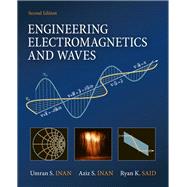Engineering Electromagnetics and Waves is designed for upper-division college and university engineering students, for those who wish to learn the subject through self-study, and for practicing engineers who need an up-to-date reference text. The student using this text is assumed to have completed typical lower-division courses in physics and mathematics as well as a first course on electrical engineering circuits.
This book provides engineering students with a solid grasp of electromagnetic fundamentals and electromagnetic waves by emphasizing physical understanding and practical applications. The topical organization of the text starts with an initial exposure to transmission lines and transients on high-speed distributed circuits, naturally bridging electrical circuits and electromagnetics.
Teaching and Learning Experience
This program will provide a better teaching and learning experience–for you and your students. It provides:
- Modern Chapter Organization
- Emphasis on Physical Understanding
- Detailed Examples, Selected Application Examples, and Abundant Illustrations
- Numerous End-of-chapter Problems, Emphasizing Selected Practical Applications
- Historical Notes on the Great Scientific Pioneers
- Emphasis on Clarity without Sacrificing Rigor and Completeness
- Hundreds of Footnotes Providing Physical Insight, Leads for Further Reading, and Discussion of Subtle and Interesting Concepts and Applications








